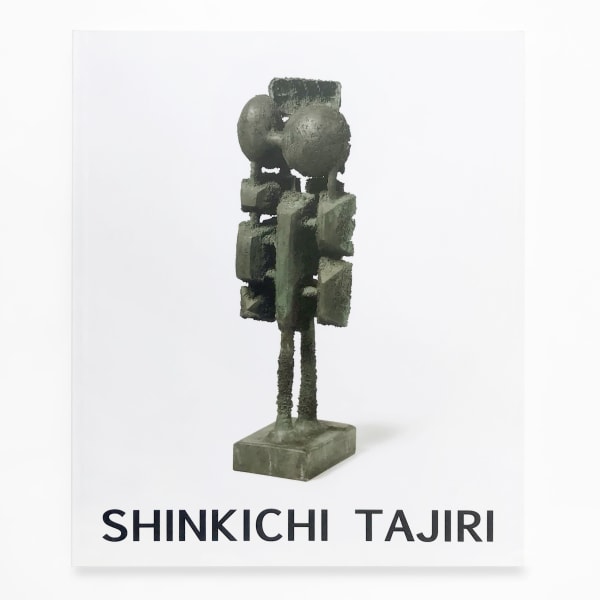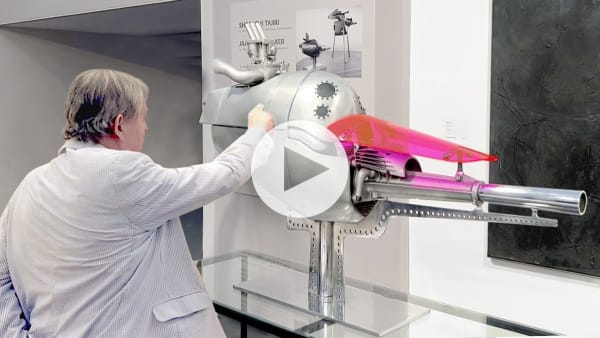Shinkichi Tajiri Dutch-American, 1923-2009
Shinkichi Tajiri (b.1923 Los Angeles, USA – d. 2009 Baarlo, NL) was a child of first-generation immigrants to the USA from Japan, and grew up in the US. Following the Japanese attack in Hawaii the Tajiri family were detained in a US internment camp and lost their family home. More to escape the camp than out of Patriotism, Tajiri enlisted in the highly decorated all-Japanese American regiment of the American Army. After attending the Chicago Art Institute from 1946 to 1948 and working for the sculptor Isamu Noguchi in New York, he moved to Paris in 1949 and joined the CoBrA group showing at the 1949 CoBrA exhibition at the Stedelijk Museum, Amsterdam. In Paris he studied with Ossip Zadkine and Fernand Léger becoming a significant figure in the group of dispossessed Post-War artists, who, after the physical and moral devastation dreamed of a universal art that would transcend borders and nations.
Primarily a sculptor, the themes of Erotica, War and Violence were a way of Tajiri crystalising the horrors he had personally experienced expressed in his repeated imagery of the Knot and The Warrior, with his 1967-68 series Machines as a form of protest on the Vietnam War. Tajiri also made a number of award-winning films, videos, photographic series, works on paper and latterly, Computer Art residing in The Netherlands from 1956 onwards with his wife, Dutch artist Ferdi. One of the innovators of post-war Dutch sculpture Tajiri has work in the collections of all the major Dutch museums as well as MoMA, NY and The National Museum of Art, Japan. A major sculpture, Machine No.6, 1967, was acquired this year by Tate Modern.
-
 Shinkichi TajiriVertical Overhand Knot, 2008Executed and cast 2008
Shinkichi TajiriVertical Overhand Knot, 2008Executed and cast 2008
Aluminum95.5 x 25 x 26 cm
37 5/8 x 9 7/8 x 10 1/4 inches -
 Shinkichi TajiriOverhand Knot, 1999Executed and cast 1999
Shinkichi TajiriOverhand Knot, 1999Executed and cast 1999
Cast iron97 x 47.5 x 26.5 cm
38 1/4 x 18 3/4 x 10 3/8 inches -
 Shinkichi TajiriGranny's Knot, 1995Cast iron31.5 x 43.5 x 11 cm
Shinkichi TajiriGranny's Knot, 1995Cast iron31.5 x 43.5 x 11 cm
12 3/8 x 17 1/8 x 4 3/8 inches -
 Shinkichi TajiriRonin, 1995Executed and cast 1995
Shinkichi TajiriRonin, 1995Executed and cast 1995
Bronze67.5 x 43 x 33 cm
26 5/8 x 16 7/8 x 13 inches -
 Shinkichi TajiriFolded Overhand Knot, 1994Executed and cast 1994
Shinkichi TajiriFolded Overhand Knot, 1994Executed and cast 1994
Bronze63.5 x 35.5 x 36 cm
25 x 14 x 14 1/8 inches -
 Shinkichi TajiriTriangular Knot, 1993Executed and cast 1993
Shinkichi TajiriTriangular Knot, 1993Executed and cast 1993
Bronze52 x 125 x 24 cm
20 1/2 x 49 1/4 x 9 1/2 inches -
 Shinkichi Tajiri(K)not for Queen, 1990Executed and cast 1990
Shinkichi Tajiri(K)not for Queen, 1990Executed and cast 1990
Bronze38.5 x 100 x 22.5 cm
15 1/8 x 39 3/8 x 8 7/8 inches -
 Shinkichi TajiriVertical Overhand Knot, 1974 c.Executed and cast c. 1974
Shinkichi TajiriVertical Overhand Knot, 1974 c.Executed and cast c. 1974
Bronze225 x 45 x 45 cm
88 5/8 x 17 3/4 x 17 3/4 inches -
 Shinkichi TajiriAstronaut, 1972Executed and cast 1972
Shinkichi TajiriAstronaut, 1972Executed and cast 1972
Aluminium16.5 x 18.5 x 37 cm
6 1/2 x 7 1/4 x 14 5/8 inches -
 Shinkichi TajiriTower of Babel, 1969Bronze55 x 26 x 26 cm
Shinkichi TajiriTower of Babel, 1969Bronze55 x 26 x 26 cm
21 5/8 x 10 1/4 x 10 1/4 inches -
 Shinkichi TajiriKnots, 1968 c.Polyester37 x 95 cm
Shinkichi TajiriKnots, 1968 c.Polyester37 x 95 cm
14 5/8 x 37 3/8 inches -
 Shinkichi TajiriWhite Night Watcher, 1966Aluminium63 x 28 x 59 cm
Shinkichi TajiriWhite Night Watcher, 1966Aluminium63 x 28 x 59 cm
24 3/4 x 11 x 23 1/4 inches -
 Shinkichi TajiriColumn for Meditation, 1965Bronze79 x 18 x 18 cm
Shinkichi TajiriColumn for Meditation, 1965Bronze79 x 18 x 18 cm
31 1/8 x 7 1/8 x 7 1/8 inches -
 Shinkichi TajiriInside Outside, 1964Bronze52 x 25 x 20.5 cm
Shinkichi TajiriInside Outside, 1964Bronze52 x 25 x 20.5 cm
20 1/2 x 9 7/8 x 8 1/8 inches -
 Shinkichi TajiriWarrior, 1964Bronze94 x 33 x 34.3 cm
Shinkichi TajiriWarrior, 1964Bronze94 x 33 x 34.3 cm
37 x 12 x 13 1/2 inches -
 Shinkichi TajiriWarrior, 1964Bronze75 x 21 x 61 cm
Shinkichi TajiriWarrior, 1964Bronze75 x 21 x 61 cm
29 1/2 x 8 1/4 x 24 inches -
 Shinkichi TajiriVictory at Maidenhead, 1962Bronze92.3 x 46 x 27 cm
Shinkichi TajiriVictory at Maidenhead, 1962Bronze92.3 x 46 x 27 cm
36 3/8 x 18 1/8 x 10 5/8 inches -
 Shinkichi TajiriFortress, 1961Bronze58 x 18 x 31 cm
Shinkichi TajiriFortress, 1961Bronze58 x 18 x 31 cm
22 7/8 x 7 1/8 x 12 1/4 inches -
 Shinkichi TajiriObiit, 1961Bronze and copper105 x 38 cm
Shinkichi TajiriObiit, 1961Bronze and copper105 x 38 cm
41 3/8 x 15 inches -
 Shinkichi TajiriObiit, 1961Bronze81 x 26 x 24 cm
Shinkichi TajiriObiit, 1961Bronze81 x 26 x 24 cm
31 7/8 x 10 1/4 x 9 1/2 inches -
 Shinkichi TajiriInterplanetary Station, 1957Brass132 x 21 x 25 cm
Shinkichi TajiriInterplanetary Station, 1957Brass132 x 21 x 25 cm
52 x 8 1/4 x 9 7/8 inches -
 Shinkichi TajiriLock, 1955Iron61 x 45 x 31 cm
Shinkichi TajiriLock, 1955Iron61 x 45 x 31 cm
24 x 17 3/4 x 12 1/4 inches -
 Shinkichi TajiriManscape, 1950Cast 1992
Shinkichi TajiriManscape, 1950Cast 1992
Cast iron145 x 29 x 30 cm
57 1/8 x 11 3/8 x 11 3/4 inches -
 Shinkichi TajiriDavid and Mrs. Goliath, 1949Cast posthumously 2012
Shinkichi TajiriDavid and Mrs. Goliath, 1949Cast posthumously 2012
Bronze52 x 24 x 23 cm
20 1/2 x 9 1/2 x 9 inches
-

Tajiri / Wagemaker
14 Nov - 15 Dec 2023Celebrating the centennial of Shinkichi Tajiri (b. 1923 Los Angeles, USA – d. 2009 Baarlo, The Netherlands), The Mayor Gallery continues it's Frieze Masters presentation exhibiting at our gallery a...Read more -

Frieze Masters
Tajiri / Wagemaker 11 - 15 Oct 2023“We cannot take anything away from the earth; we can only change its shape.” - Jaap Wagemaker To celebrate the centennial of Shinkichi Tajiri(b. 1923 Los Angeles, USA...Read more -

In Real Life
9 Jun - 29 Jul 2021After months of only following the artworld through our screens, many of us now miss the experience of seeing art in person. This Summer The Mayor Gallery celebrates that irreplaceable...Read more -

SHINKICHI TAJIRI
15 Feb - 30 Mar 2017Shinkichi Tajiri (b. 1923 Los Angeles, USA – d. 2009 Baarlo, The Netherlands) is primarily a sculptor who plays with the themes of violence and eroticism in metal assemblages where...Read more
-

Shinkichi Tajiri : Americans in Paris
Grey Art Museum, New York March 2, 20242 Mar - 20 Jun 2024 Following World War II, hundreds of artists from the United States flocked to the City of Light, which for...Read more -

Shinkichi Tajiri : The Restless Wanderer
Bonnefanten, The Netherlands December 4, 2023Shinkichi Tajiri: The Restless Wanderer, opens tonight at Bonnefanten in Maastricht. This deeply personal exhibition is curated by his own grandchildren, Tanéa & Shakuru Tajiri....Read more -

Tate Acquires Shinkichi Tajiri
October 13, 2023We are exited to share the news that the Tate has acquired the major work ‘Machine No. 6’, 1967 by Tajiri from The Mayor Gallery.Read more -

Walk-Around | Frieze Masters 2023
With James Mayor October 13, 2023Click below to view nn in depth tour of our stand at Frieze Masters 2023 conducted by James Mayor. Fair dates: 11 - 15 October...Read more -

Frieze Masters
Tajiri / Wagemaker October 2, 202311 - 15 OCTOBER 2023 STAND D12 ANNOUNCING participation in this year's Frieze Masters in collaboration with BorzoGallery and Matthijs Erdman a duo presentation of...Read more




































